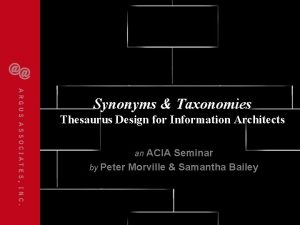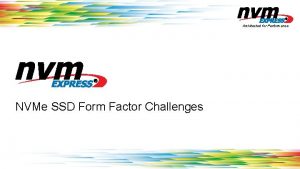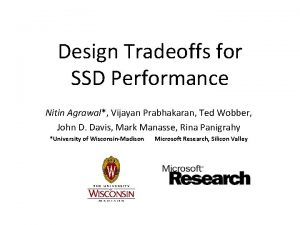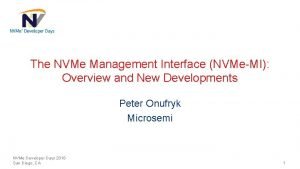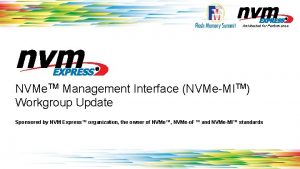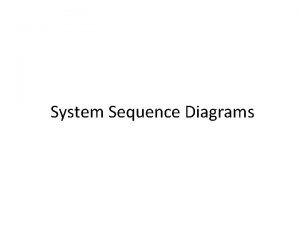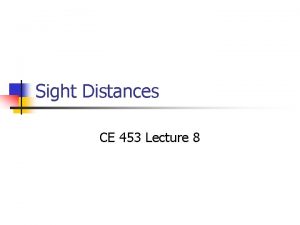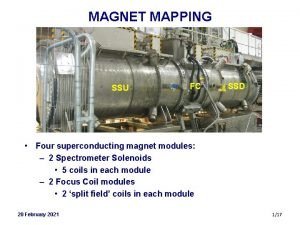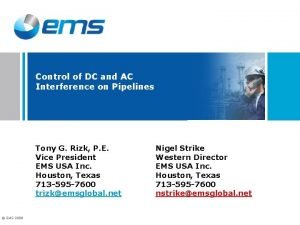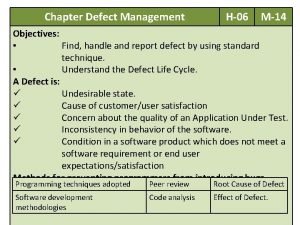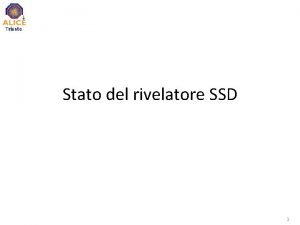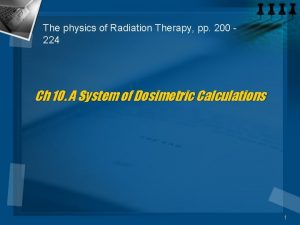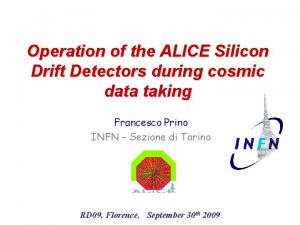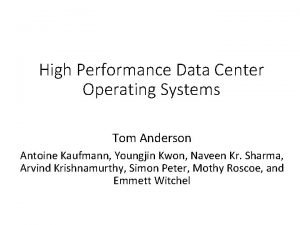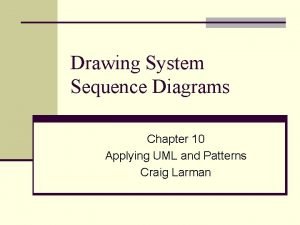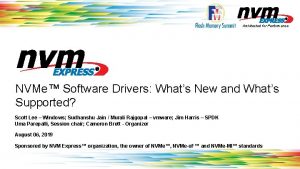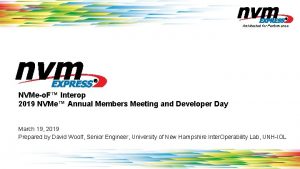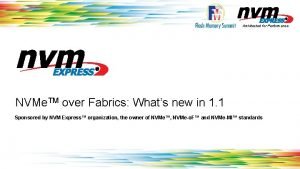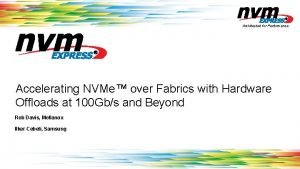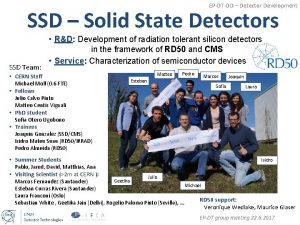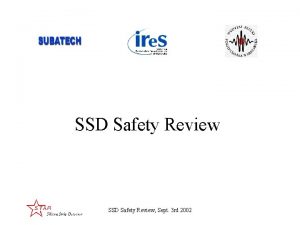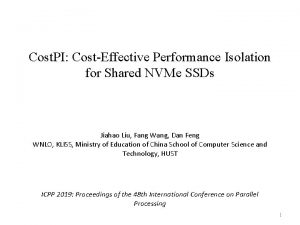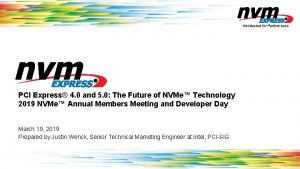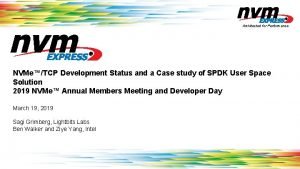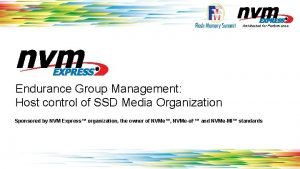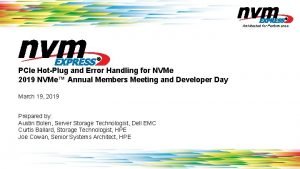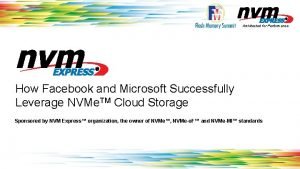Architected for Performance NVMe SSD Form Factor Challenges





















- Slides: 21

Architected for Performance NVMe SSD Form Factor Challenges

Agenda • A little bit of history • Summary of potential NVMe SSD form factors • System architectural challenges • Server platforms • Hyper-scale platforms • Client platforms Presenters – – Bill Lynn Michael Krause Jonathan Hinkle Chris Petersen Dell/EMC HPE Lenovo Facebook 2

History HDD’s Form Factor Introduction Present • 1956 Refrigerator 3. 75 MB • 1975 Washing Machine 92 MB • 1980 5. 25” 5 MB • 1983 3. 5” 10 MB 12 TB • 1988 2. 5” 20 MB 4 TB • 1991 1. 8” 21 MB 250 GB • 1992 1. 3” 20 MB • 2009 m. SATA 500 GB • 2013 M. 2 1 TB SSD’s 3

HDD / SSD Architecture HDD Exploded View SSD Exploded View 4

Potential NVMe SSD Form Factors SFF-TA-1008 AIC SFF-TA-1007 2. 5 in U. 2 NGSFF m. 2 5

PCIe M. 2 Applicable market segments § Embedded / T&M, Client, Data center (e. g. , SSD carrier) § Connector and BGA solutions Supported Connectors § x 1 / x 2: Mid-mount, single-sided, double-sided M. 2 Benefits: § Large, flexible mechanical form factor family § Supports multiple protocols: PCIe/NVMe, SATA, USB, etc. § Supports 14 vendor-defined pins to customize solutions § Forward / backward compatibility § Low power (3. 3 V & 1. 8 V using 4 power pins) § Supports external connectivity: cables, antennae, etc. § Multiple M. 2 can be provisioned on a carrier form factor 6

U. 2 2. 5” SSD Applicable market segments § Primarily data center with some enthusiast desktop Size § 15 x 70 x 100. 45 mm up to 25 W Supports SFF-8639 (PCIe x 4) U. 2 Benefits: § Adds PCIe support to high-volume 2. 5” HDD form factor § Supports PCIe up to 16 GT/s § High-capacity / high-density NVMe form factor § Up to 24 modules in 2 U enclosure § Up to 14 x 18 mm packages per module § Case for ESD protection and hot-plug support 7

SFF-TA-1006 Applicable market segments § Data Center (optimized as scalable main storage and acceleration in server and storage systems) Size § 31. 5 mm x 111. 5 mm x 5. 75 or 7. 55 mm, supports up to 12 W caseless Supports SFF-TA-1002 1 C (PCIe x 4) SFF-TA-1006 Benefits: § PCIe to 32+ GT/s § High-capacity / high-density NVMe form factor • Up to 36 modules across 1 U rack space • Up to 12 14 x 18 mm packages per module • 432 packages / U § Supports integrated data-centric computation § Case & Case-less Options 8

SFF-TA-1007 Applicable market segments § Data Center (1 U optimized server and storage enclosure) Sizes § 9. 5 x 38. 4 x 318. 75 mm supports up to 25 W § 18 x 38. 4 x 318. 75 mm supports up to 40 W § Adds heat sink to improve cooling at system density expense Supports SFF-TA-1002 2 C (PCIe x 4 -x 8) SFF-TA-1007 Benefits: § PCIe to 32 GT/s § High-capacity / high-density NVM form factor § 9. 5 mm – Up to 32 modules – Up to 44 14 x 18 mm packages per module – 1408 packages / U § 18 mm – Up to 18 modules – Up to 44 14 x 18 mm packages per module – 704 packages / U § Supports data-centric computation § Reduce packages to free up space for integrated accelerator § Case for ESD protection, thermal management, & hot-plug 9

SFF-TA-1008 Applicable market segments § Data Center (1 U and 2 U optimized server and storage enclosure) Sizes § § 7. 5 x 76 x 104. 9 mm supports up to 25 W 7. 5 x 76 x 142. 2 mm supports up to 35 W 16. 8 x 76 x 104. 9 mm supports up to 70 W 16. 8 x 76 x 142. 2 mm supports up to 70 W Supports SFF-TA-1002 1 C, 2 C, 4 C (PCIe x 4 -x 16) SFF-TA-1008 Benefits: § PCIe to 32 GT/s, 802. 3 to 112 GT/s § High-capacity / high-density NVM form factor § 7. 5 mm – Up to 48 modules – 104. 9 up to 24 14 x 18 mm packages per module (576 / U) – 142. 2 up to 48 14 x 18 mm packages per module (960 / U) § 16. 8 mm – Up to 24 modules – Up to 48 14 x 18 mm flash packages per module (960 / U) § Supports data-centric computation § Reduce packages to free up space for integrated accelerator § Case for ESD protection and hot-plug support 10

Summary of Proposed Form Factors Form Factor 2. 5” (Baseline) M. 2 SFF-TA-1008* (Short) SFF-TA-1008* (Long) NGSFF* SFF-TA-1006* SFF-TA-1007* Width (mm) 70 22 76 76 30. 5 31. 5 38. 4 Length (mm) 100. 45 60/80/110 104. 9 142. 2 110 111. 5 318. 75 Thick (mm) 15 3. 0 7. 5 4. 3/4. 8 5. 75/7. 55 9. 5 Front Slots 24 N/A 48 48 72 72 64 Power (Max) 25 8. 5 20 35 16 12** 25 Pkgs (14 x 18) 32 2/4/8 24 40 12 12 44 *Newer form factors also support wide versions for higher capacity **12 W TDP supportable for caseless version 11

Classical 2 S Rack Server Architecture • Typical rack server could be divided into thirds • Front third typically for storage and supporting infrastructure • Need to consider: • Cooling • Power • Storage performance • Memory performance • Networking performance • I/O capability Drive Bays Expansion Fans Storage CPU & Memory Power & I/O 12

Server Design Considerations 13

Storage Subsystem Design Considerations • Must balance drive size and host interface width with performance and capacity • PCIe lanes available for NVMe storage in systems are going up, but drive performance is bounded by host interface • Higher performance PCIe generations (PCIe 3. 0 > PCIe 4. 0 > PCIe 5. 0) may allow drive interface widths to go down (x 4 > x 2 > x 1) • Scaling storage beyond host PCIe lanes drives significant cost by addition of PCIe switches and additional interconnect Could be same capacity Higher performance, utilize more of the performance from flash in each drive Fewer drives with higher capacity and x 8 has no interconnect or switching cost benefits (i. e. 2 x 4 = 1 x 8) 14

Power and Thermal System Design Considerations Power delivery • Drive power • Overall system power budget Lower voltage Higher current density Higher voltage Lower current density • Prefer lower current in system designs: higher voltage like +12 V is useful • Power density of drive vs. complexity and cost of thermal solution • Drive pre-heat vs. keeping downstream system components cool System Airflow • Drive dimensions and drive spacing in system • Airflow restriction through drives • Exposed surface area of drive for heat transfer drive spacing 15

How do hyper-scalers use flash today? M. 2 s 16

M. 2 Carriers 17

Hyper-scale NVM Form Factor Characteristics Important: Less important: • Flexible • Backwards compatible • High volume • Support for non-NVM media • Low cost • Maximum density • Power and thermal efficiency • Hot swappable • Serviceable Call to Action: Consolidate to a small number of form factors (<= 4) 18

Client Challenges • Size, power, and cost are the biggest issues • Many OEMs are planning on moving to NVMe on client platforms in the near future. • Dependencies include: • Cost • Lowering the active idle power 2. 5” x 7 mm M. 2 2280 M. 2 2230 BGA 19

2 0 Cards beginning to adopt NVMe § SDA adding PCIe/NVMe interface to SD card (1) SD-PCIe (2) § More content (4 K/8 K content, Social Media) § More content generators (Drones, Action Cam, 360, VR § CFA adding NVMe/PCIe (CFexpress) for high end photography CFexpress § Resolution (push to 8 K RAW) § Color Gamut – Ultra. HD Rec 2020 § Higher Frame Rates (motion blur) § Dynamic Range § Use cases require existing NVMe/PCIe features and will create demand for new features (1) Currently under definition in SDA’s Spec WG (2) The micro. SD-PCIe card illustration is shown just for this presentation and it does not represent any official SDA standard, yet. 20

Architected for Performance
 Architected synonym
Architected synonym Sff-ta-1008
Sff-ta-1008 Design tradeoffs for ssd performance
Design tradeoffs for ssd performance Nvme-mi
Nvme-mi Nvme-mi spec
Nvme-mi spec Constant phase difference
Constant phase difference Topic 7 economic performance and challenges
Topic 7 economic performance and challenges Ssd diagram
Ssd diagram 7 segment display resistor
7 segment display resistor Ssd 1306
Ssd 1306 Formula of stopping sight distance
Formula of stopping sight distance Sdram vs rdram
Sdram vs rdram Ssd and magnets
Ssd and magnets Harde schijf klonen met acronis
Harde schijf klonen met acronis Zinc ribbon ac mitigation installation
Zinc ribbon ac mitigation installation Choose the work product wise defect classification ssd fsd
Choose the work product wise defect classification ssd fsd Estimate expected impact of a defect
Estimate expected impact of a defect Ssd trieste
Ssd trieste Ssd and sad technique in radiotherapy
Ssd and sad technique in radiotherapy Ssd layer
Ssd layer Ssd layer
Ssd layer Ssd uml
Ssd uml
